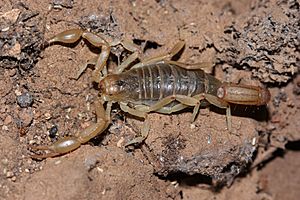Stripe-tailed scorpion facts for kids
Quick facts for kids Stripe-tailed scorpion |
|
|---|---|
 |
|
| Scientific classification | |
| Genus: |
Paravaejovis
|
| Species: |
spinigerus
|
| Synonyms | |
|
|
Paravaejovis spinigerus, also known as the stripe-tailed scorpion or devil scorpion, is a type of scorpion. It belongs to the Vaejovidae family. This scorpion lives in the southwestern United States and northwestern Mexico.
Contents
About the Stripe-Tailed Scorpion
The stripe-tailed scorpion is a medium-sized scorpion. Adult males and females can grow to be about 60–70 millimeters (about 2.4–2.8 inches) long. They usually weigh around 9.5 grams.
You can tell this scorpion apart from the Arizona bark scorpion by its tail. The stripe-tailed scorpion has brownish-tan stripes on the back of its tail. These stripes follow the ridges on its tail. Its tail is also usually thicker than its pincers. The Arizona bark scorpion has very thin pincers and tail. Some stripe-tailed scorpions might be light yellow or golden-brown. They can also have darker markings on their tails. The name spinigerus comes from the small, spine-like bumps on the end of its tail ridges.
Before 2013, this scorpion was known by a different name. It was classified in the genus Hoffmannius.
Where They Live
The stripe-tailed scorpion lives in the Sonoran Desert. This desert stretches across northwestern Mexico and the southwestern United States. You can find them in places like Arizona, New Mexico, and parts of California. In Mexico, they live in Sonora, Baja California, and Baja California Sur.
These scorpions often hide under rocks or other objects on the ground. They might be under sleeping bags or shoes. They like sandy areas in many different habitats. You can find them from the desert floor up to rocky hillsides. They always look for the most humid or damp spots they can find.
Scorpion Life and Habits
What They Eat
Like most scorpions, Paravaejovis spinigerus mainly eats small invertebrates. This includes other scorpions. They also eat insects like crickets, mealworms, and roaches.
Who Eats Them
Many animals prey on the stripe-tailed scorpion. These include pallid bats and "sand-swimmer" snakes. Spiders, centipedes, lizards, and birds also eat them. Some mammals and even other scorpions will hunt them.
Scorpion Venom
All scorpions have venom. However, the venom of the stripe-tailed scorpion is not very strong for humans. It is not considered dangerous to people or other mammals. If you get stung, it might hurt, but it won't cause serious medical problems.
Reproduction and Life Cycle
Stripe-tailed scorpions use smell and vibrations to find a mate. When a male and female meet, they might do a special "dance." This dance can last from a few minutes to several hours. After the dance, they usually go their separate ways. Sometimes, if the male continues the dance longer than the female, she might attack him.
Baby scorpions grow inside the female's body. They are born alive, not from eggs. The female's body looks stiff and rigid during this time. This period, called gestation, usually lasts for 3 to 8 months. When it's time for birth, her front legs lower. This allows the baby scorpions, called "scorplings," to come out. Some scorplings emerge one at a time. Others might come out all at once in a steady flow. The mother stays stiff until all her babies are born.
She will care for her babies and carry them on her back. She does this until they go through their first molting period. A mother scorpion can have anywhere from 1 to 100 babies at once. Depending on the scorpion species and their environment, mothers might care for their young or, in some rare cases, eat them. Scientists are still studying why this happens.
See also
 In Spanish: Alacrán amarillo cola rayada para niños
In Spanish: Alacrán amarillo cola rayada para niños

